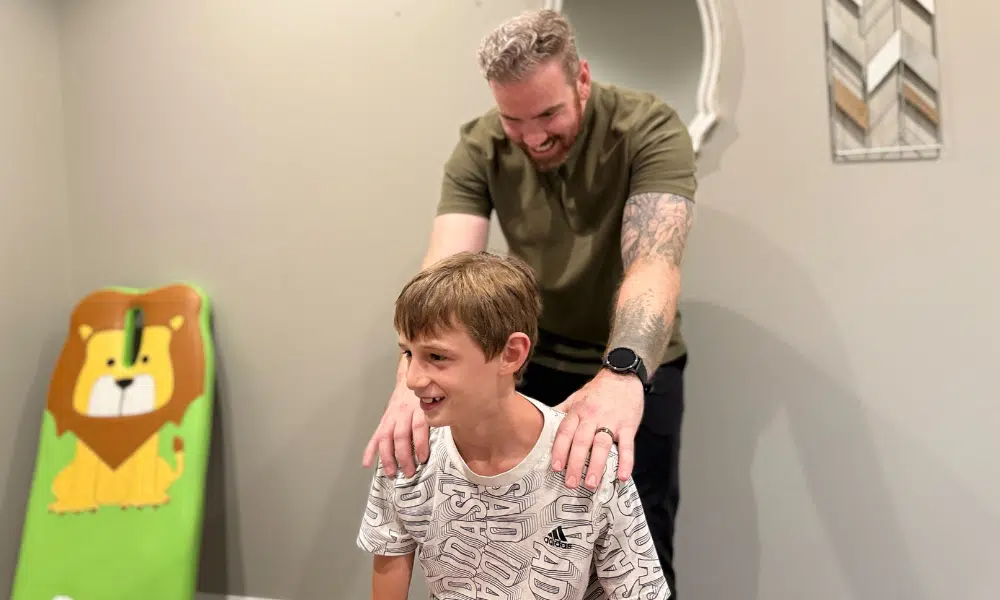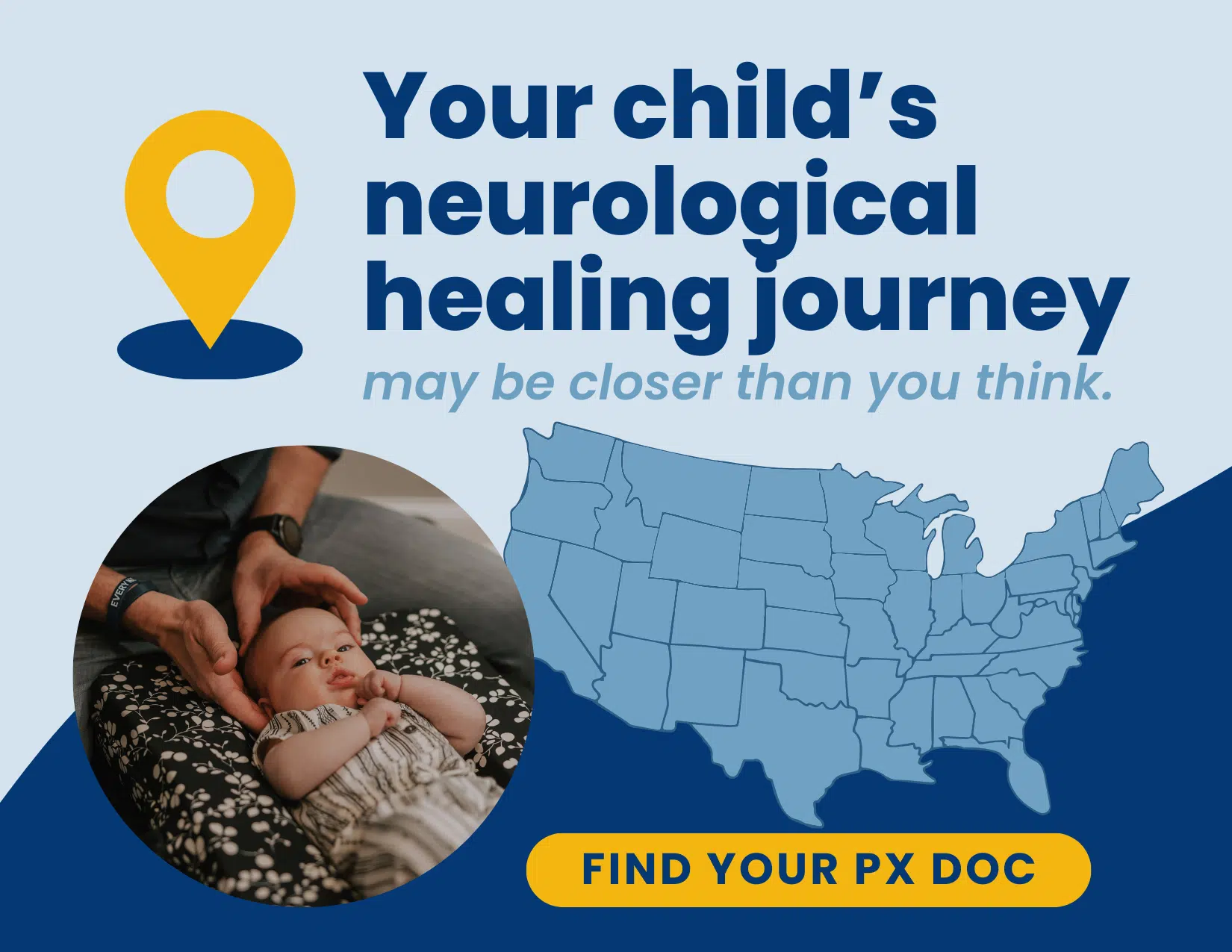As a parent, you’ve watched your child grow and develop over the years, celebrating their successes and supporting them through their struggles. Now, as they enter their teenage years, you may find yourself facing new challenges, especially if your teen has been diagnosed with Attention-Deficit/Hyperactivity Disorder (ADHD).
ADHD is a neurodevelopmental condition characterized by persistent inattention, hyperactivity, and impulsivity. While often diagnosed in childhood, ADHD can continue to impact individuals throughout their lives, and the teenage years can be a particularly challenging time. Recent CDC data shows that 14.3% of adolescents aged 12-17 have been diagnosed with ADHD, making it a common concern for parents and caregivers.
During adolescence, teens face increased academic demands, complex social dynamics, and heightened emotional sensitivity. For those with ADHD, these challenges can be amplified, leading to difficulties in school, strained relationships with peers and family members, and feelings of frustration or low self-esteem.
As a parent or caregiver, you play a crucial role in helping your teen navigate this transformative period. Current research demonstrates that by understanding the unique ways in which ADHD affects adolescents and learning effective drug-free strategies to support your teen, you can foster their success and well-being.
Understanding ADHD in Teens
To effectively support your teen with ADHD, it’s essential to have a comprehensive understanding of the condition and how it can manifest during adolescence. ADHD is characterized by three core signs: inattention, hyperactivity, and impulsivity. Research consistently shows that boys and men typically exhibit more hyperactive and impulsive behaviors, whereas girls are more likely to display inattentive ADHD.
While these signs are present throughout an individual’s life, they may present differently in teens compared to younger children.
Inattention in teens with ADHD may manifest as:
- Difficulty focusing on tasks, especially those that are lengthy or require sustained mental effort
- Struggles with organization and time management
- Forgetfulness in daily activities and responsibilities
- Apparent lack of listening when spoken to directly
- Tendency to lose items necessary for tasks or activities
Hyperactivity and impulsivity in teens with ADHD may present as:
- Restlessness or fidgeting, even when expected to remain seated
- Talking excessively or interrupting others
- Difficulty waiting for their turn or engaging in leisure activities quietly
- Acting on impulses without considering consequences
- Making rash decisions or displaying poor judgment
Complexities of ADHD in Teens
It’s important to note that ADHD symptoms in teens can vary in severity and presentation among individuals. Some teens may primarily struggle with inattention, while others may exhibit more hyperactive or impulsive behaviors. Additionally, signs may fluctuate depending on the environment and the demands placed on the teen.
During adolescence, teens with ADHD encounter specific challenges that can worsen their symptoms. Increased academic demands and greater responsibility for time management are particularly tough for those with attention deficits. Additionally, social pressures to fit in can heighten stress and emotional dysregulation, leading to more impulsive behaviors. In fact, research indicates that teens with ADHD are more prone to engage in risky behaviors, such as substance use and unsafe sexual activity.
Furthermore, teens with ADHD often struggle with executive functioning skills, such as planning, organization, and self-monitoring. These challenges can lead to missed deadlines, lost assignments, and difficulty prioritizing tasks, which can contribute to academic underachievement and feelings of frustration or inadequacy.
By understanding the complexities of ADHD in teens and recognizing the unique challenges they face, parents and caregivers can develop a more empathetic and targeted approach to support. In the following sections, we’ll explore strategies for addressing these challenges and fostering your teen’s success.
Impact of ADHD on Various Aspects of a Teen’s Life
ADHD in teens can have far-reaching effects on their lives, influencing their academic performance, social relationships, family dynamics, and emotional well-being. Understanding these impacts is crucial for developing effective strategies to support your teen’s success and overall quality of life.
Academic performance and school-related challenges
ADHD in teens often causes a struggle with academic demands, leading to lower grades, incomplete assignments, and frustration. Some common challenges include:
- Difficulty sustaining attention during lectures or while completing homework
- Struggles with organization and time management, leading to missed deadlines or last-minute cramming
- Impulsivity leading to careless mistakes or rushed work
- Disruptive behavior in the classroom due to hyperactivity or impulsivity
Social relationships and peer interactions
ADHD can also impact a teen’s social life, making it harder to form and maintain friendships. Some of the ways ADHD may affect social relationships include:
- Difficulty reading social cues or understanding personal boundaries
- Impulsivity leading to inappropriate comments or actions
- Struggles with taking turns or sharing in group activities
- Hyperactivity or restlessness makes it hard to engage in quiet activities with friends
Family dynamics and communication
Living with a teen with ADHD can be challenging for the entire family. Signs of ADHD may contribute to:
- Increased conflict or arguments due to impulsivity or emotional dysregulation
- Frustration or stress among family members related to disruptive behavior or academic struggles
- Difficulty establishing and maintaining consistent routines or expectations
- Strained communication due to inattention or impulsivity
Emotional well-being and self-esteem
Teens with ADHD often face emotional challenges as a result of their symptoms and the impact on various areas of their lives. These challenges may include:
- Feelings of inadequacy or low self-esteem due to academic or social struggles
- Increased risk of anxiety or depression related to chronic stress or frustration
- Difficulty regulating emotions, leading to outbursts or mood swings
- Sense of isolation or loneliness due to social challenges
Recognizing the pervasive impact of ADHD on your teen’s life is an essential step in providing the necessary support and resources. However, rather than simply managing symptoms, it’s crucial to understand that ADHD isn’t something that needs “fixing” – it’s something that needs fine-tuning and regulation.
ADHD as a Superpower: Reframing Your Teen’s Neurological Wiring
Before diving into root causes, it’s important to understand that ADHD brains come with incredible strengths. Think of it this way: your teen has a Ferrari engine for a brain, but they may have Ford Focus brakes and handling. The goal isn’t to slow down the Ferrari – it’s to upgrade the brakes and suspension so they can handle the power.
Scientific research demonstrates that children and teens with ADHD often excel in:
- Problem-solving – Studies indicate that the multi-layered nature of complex challenges is actually attractive to the ADHD brain
- Enhanced pattern recognition – Research shows ADHD brains constantly scan their surroundings, picking up details others miss
- Imagination and creativity – Multiple studies confirm the rapid-fire thinking creates unique connections and ideas
- Compassion and empathy – Deep emotional sensitivity when properly regulated
- Laser focus on what they love – Incredible concentration when engaged with preferred activities
- Endless energy – When channeled properly, this becomes a tremendous asset
Some of the most successful people in the world have thrived with it. From entrepreneurs to athletes, artists to innovators, many individuals with ADHD harness traits like intense focus on areas of interest, high energy, creativity, and the ability to think outside the box to achieve remarkable success.
Their brains may work differently, but that difference often becomes a unique advantage when paired with the right strategies and support. Rather than holding them back, ADHD can fuel innovation, risk-taking, and relentless drive—qualities that have propelled countless people to the top of their fields.
Understanding the Real Root Cause of ADHD in Teenagers
Medical research confirms that the conventional medical narrative claiming ADHD is caused by a “chemical imbalance” is now known to be outdated and wildly incomplete. While neurotransmitters are involved, it can’t be a “chemical” imbalance without first being a neurological imbalance.
Debunking the Chemical Imbalance Theory
Independent studies demonstrate that traditional medicine focuses on symptom management through medications that suppress brain function, but this approach misses the mark. Research indicates that the real root cause lies much deeper – in stress and dysfunction of the central and autonomic nervous system. When we use analogies to explain this to families, we talk about the “gas pedal” (sympathetic nervous system) being stuck on, while the “brake pedal” (parasympathetic nervous system) isn’t working properly.
The Neurological Foundation of ADHD
ADHD is fundamentally a condition of nervous system dysregulation, specifically involving:
Subluxation and Sympathetic Dominance: Rather than structural misalignments, we’re talking about neurological interference that creates a “stuck on stress mode” nervous system. This sympathetic dominance means the brain is constantly in fight-or-flight, making it nearly impossible to focus, sit still, or regulate emotions.
Vagus Nerve Dysfunction: The vagus nerve is the key “brake pedal” of the nervous system. When it’s not functioning optimally due to early trauma or stress, it can’t properly calm and regulate the overactive sympathetic system. This dysfunction directly impacts attention, emotional control, and behavioral responses.
Dysautonomia: This is the technical term for when the autonomic nervous system is out of balance. Instead of smooth coordination between “gas” and “brake,” you get either a “Raging Bull” (hyperactive type) or “Drunken Bull” (inattentive type) presentation.
The “Perfect Storm” Leading to ADHD: Birth Trauma as the Missing Link
The most overlooked aspect of ADHD is birth trauma – the physical injury that occurs during labor and delivery. Some research suggests this is often a primary trigger that sets everything else in motion, creating what we call the “Perfect Storm.”
Birth Interventions and Physical Trauma: Studies indicate that C-sections, forceps, vacuum extraction, induction, and prolonged labor can cause significant trauma to the delicate brainstem and upper neck region where the vagus nerve originates. This physical stress creates subluxation and gets the nervous system “stuck” in sympathetic dominance from day one.
The Cascade Effect: Once this neurological dysfunction is established, it creates a domino effect:
- Poor digestion and gut health (research shows the vagus nerve significantly controls gastrointestinal function)
- Frequent ear infections and respiratory issues
- Sleep difficulties and behavioral challenges
- Delayed motor milestones that are crucial for brain development
- Sensory processing difficulties & more
Motor Development Connection: Research demonstrates that movement and coordination play crucial roles in brain development. When birth trauma disrupts these early motor patterns, it directly impacts the brain’s ability to develop proper attention and regulation networks.
A Neurologically-Focused Approach to Caring for ADHD
At PX Docs, we take a completely different approach to caring for teens with ADHD. Rather than suppressing symptoms with medications that come with serious side effects, we focus on restoring optimal nervous system function through Neurologically-Focused Chiropractic Care.
Advanced Neurological Assessment with INSiGHT Scans
Our approach begins with a comprehensive neurological assessment using INSiGHT Scans – advanced technology that allows us to see exactly what’s happening in your teen’s nervous system:
Surface EMG Scans reveal areas where the nervous system is “stuck” in stress patterns, often showing the classic sympathetic dominance patterns we see in ADHD.
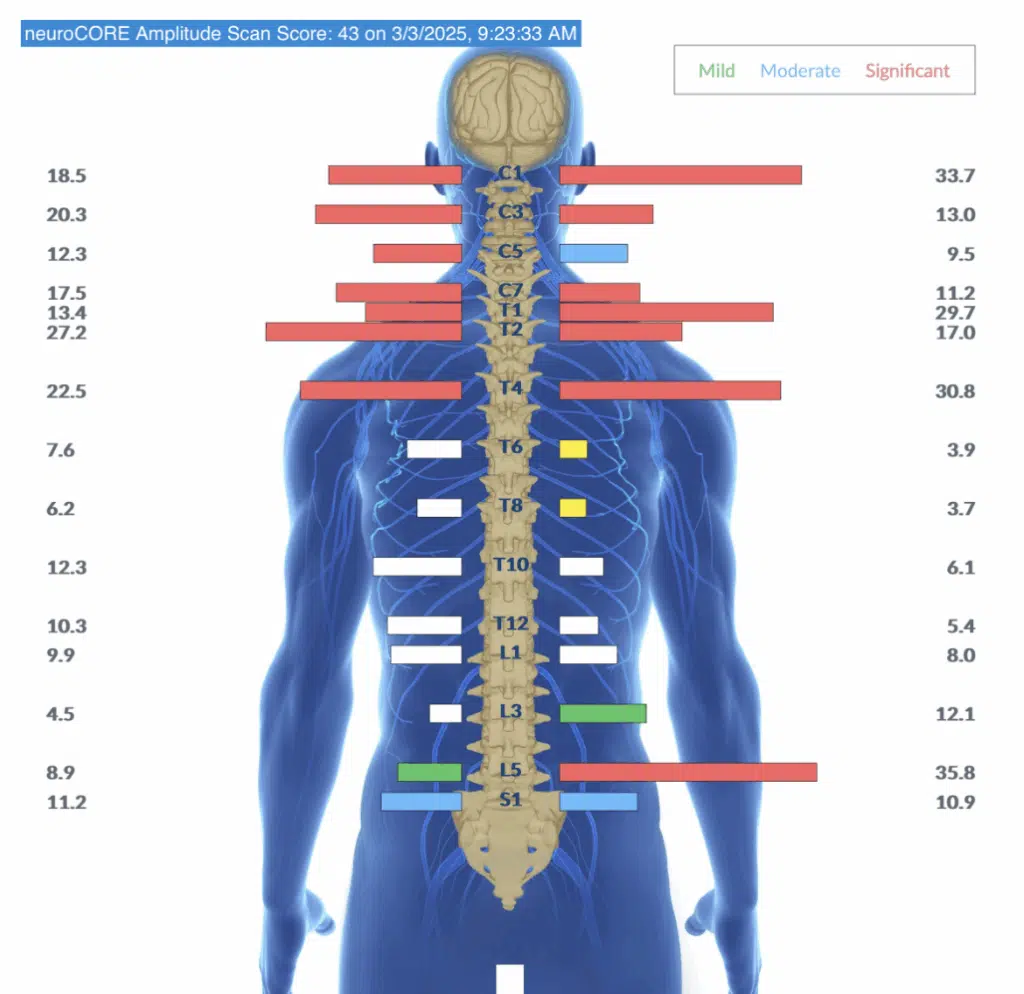
Thermal Scans detect areas of inflammation and dysautonomia throughout the nervous system, helping us identify where subluxation is interfering with normal function.
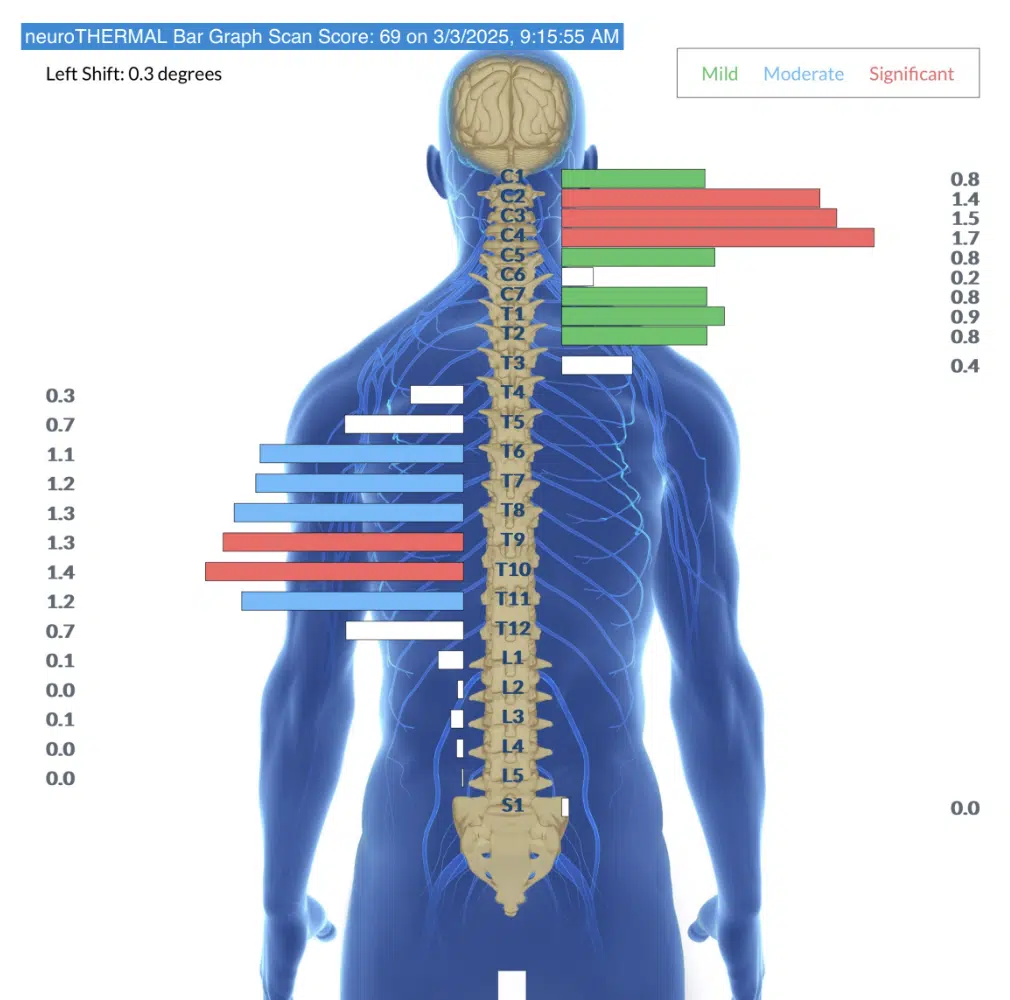
Heart Rate Variability (HRV) measures vagus nerve function and overall nervous system adaptability – multiple studies confirm that teens with ADHD typically show very poor HRV, indicating their nervous system is stuck in one gear. Meta-analyses demonstrate that ADHD is consistently associated with reduced heart rate variability and autonomic nervous system dysregulation.
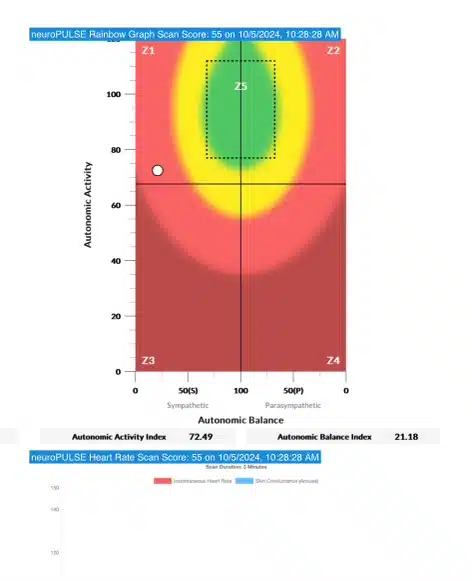
Restoring Nervous System Balance and Unleashing Potential
Through gentle, precise neurological adjustments, we work to:
- Release subluxation and restore proper nervous system communication
- Calm sympathetic dominance – essentially fixing the “stuck gas pedal”
- Activate vagus nerve function – getting the “brake pedal” working again
- Support neuroplasticity – the brain’s incredible ability to heal and rewire itself
- Restore gut-brain communication – improving digestion, sleep, and emotional regulation
The beauty of this approach is that we’re not suppressing your teen’s incredible ADHD brain – we’re giving it the neurological foundation it needs to function optimally. When the nervous system is balanced and regulated, those ADHD superpowers can truly shine.
Psychotherapy and Behavioral Interventions
In addition to Neurologically-Focused Chiropractic care, psychotherapy and behavioral interventions can be valuable tools in helping teens with ADHD develop coping strategies and improve their functioning. Some effective approaches include:
Cognitive-Behavioral Therapy (CBT): CBT helps teens identify and change negative thought patterns and behaviors related to ADHD, such as procrastination or low self-esteem. Through CBT, teens can learn practical skills for managing their challenges and improving their overall well-being. Clinical trials show that cognitive-behavioral therapy has significantly reduced core ADHD signs by 33% and also alleviated associated anxiety and depression.
Social Skills Training: Many teens with ADHD struggle with social interactions and relationships. Social skills training can help them learn and practice effective communication, empathy, and conflict-resolution skills, enhancing their ability to form and maintain friendships.
Parent-Teen Interaction Therapy: This approach focuses on improving the relationship between parents and their teens with ADHD through structured, skill-based sessions. By learning effective communication and problem-solving strategies, families can reduce conflict and foster a more supportive home environment.
Educational Accommodations and Support
Teens with ADHD often require additional support and accommodations in the educational setting to help them succeed academically. Two key tools for ensuring appropriate support are Individualized Education Plans (IEPs) and 504 Plans.
An IEP is a comprehensive document that outlines specific goals, accommodations, and support services for students with disabilities who require specialized instruction. A 504 Plan, on the other hand, ensures that students with disabilities receive accommodations and modifications necessary to access the general education curriculum, such as extended time on tests or preferential seating.
Collaborating with school professionals, including teachers, counselors, and special education staff, is crucial in developing and implementing these plans. By working together, you can ensure that your teen receives the support they need to thrive academically and build a foundation for future success.
Strategies for Managing ADHD in Teens
In addition to therapy, there are several practical strategies that teens with ADHD can use to manage their symptoms and improve their daily functioning. Implementing these strategies consistently can help teens develop essential life skills and build confidence in their abilities.
Developing effective organizational and time management skills
- Use a planner or digital calendar to keep track of assignments, deadlines, and appointments
- Break down large tasks into smaller, manageable steps
- Create a designated study space free from distractions
- Use visual aids, such as color-coded folders or sticky notes, to organize materials
Establishing consistent routines and structure
- Create a daily schedule that includes time for homework, extracurricular activities, and relaxation
- Set clear expectations and consequences for behavior
- Maintain a consistent sleep schedule and prioritize adequate rest
Utilizing technology and tools for reminders and planning
- Use smartphone apps or alarms to set reminders for important tasks or deadlines (while also limiting the overall amount of screen time on social media and shows)
- Explore assistive technology, such as text-to-speech software or smartpens, to support learning and organization
Incorporating physical activity and stress-reduction techniques
- Engage in regular exercise, such as team sports or individual activities like yoga or swimming
- Practice relaxation techniques, such as deep breathing or mindfulness meditation
- Take frequent breaks during extended periods of work or study
Fostering positive communication and relationships
- Encourage open and honest communication within the family
- Practice active listening and validate your teen’s feelings and experiences
- Model healthy coping strategies and problem-solving skills
- Encourage your teen to seek support from trusted friends, family members, or professionals when needed
Moving Forward with Hope and Resilience
Navigating ADHD in teens can be a challenging journey for both teens and their families. However, with the right support, resources, and strategies, teens with ADHD can thrive and reach their full potential.
As you continue to support your teen with ADHD, remember that progress is not always linear. There may be setbacks and obstacles along the way, but with patience, perseverance, and a commitment to ongoing learning and growth, you and your teen can navigate these challenges together.
If you’re looking to take the next step in addressing your teen’s ADHD, we encourage you to visit our PX Docs directory to find a practitioner near you. Remember, with the right support and guidance, there is no limit to what your teen can achieve.
Embrace the journey ahead with hope and resilience. Celebrate your teen’s unique strengths and talents, and encourage them to pursue their passions and dreams. Foster open communication, seek support when needed, and prioritize self-care and well-being for both yourself and your teen.

